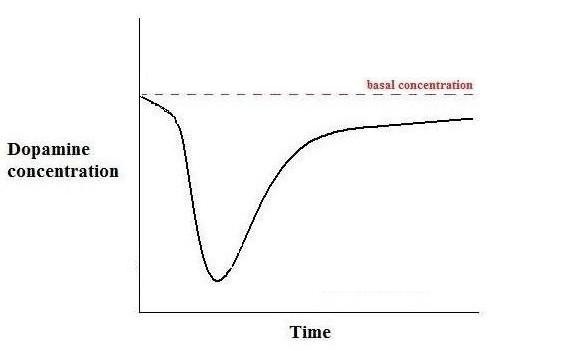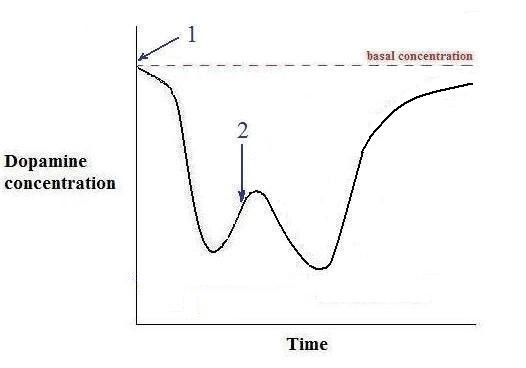The Guess Worker
The dynamics of pain
Overview:
- The brain has different synapses for pleasurable and painful stimuli
- Pleasurable stimuli cause initial rises in dopamine levels
- Painful stimuli cause initial falls in dopamine levels
- Relief is the pleasure felt after pain when dopamine rises back to basal concentrations
- Painful stimuli are less painful with repetition but the relief afterwards is greater
Some things at the outset always feel good and other things always feel bad. For most of us a mouthful of punch feels good, unless we have drunk too much of it. A punch full in the mouth, though, always feels bad, no matter what.
Up synapses and down synapses
Stimuli, it seems, are either pleasurable or painful. How, though, does consciousness tell which is which? In the last post I described how pleasurable stimuli might be signalled: initial rises in dopamine levels in certain synapses in the brain are followed by falls which are interpreted by the consciousness as pleasure and pain respectively.
So how are painful stimuli signalled? My guess is – in a similar way, only in reverse. The synapses in the brain responsible for painful and pleasurable stimuli probably use the same dopamine equilibrium and operate almost identically. But whereas for pleasurable stimuli an incoming impulse causes a rise in dopamine levels, for painful stimuli there is a fall.
There are, then, two kinds of synapses – one for pleasurable stimuli, an "up" kind, and another for painful stimuli, a "down" kind. Scientists back in the 1950's identified a region of the brain now called the "pleasure centre", and this is probably where "up" synapses are located. There doesn't seem to be any comparable pain centre; instead pain seems to be processed in several interconnected areas which collectively are known as the "pain matrix".*1 "Down" synapses are likely to be found here.*2
Mirror image
How do "down" synapses work? After receiving an impulse, dopamine levels are pushed down below the basal concentration. In time, though, as long as no more impulses are sent by incoming neurons, the levels of dopamine rise back to the basal concentration. A graph of dopamine concentration against time might look like this:
 "
"
The graph is a mirror image of the one for a synapse in a pleasure centre (see last post). A fall in dopamine is experienced as pain and a rise is felt as pleasure, so according to the graph above we would feel first pain then pleasure. The pain would be comparatively intense because the fall in dopamine is steeper; in contrast the subsequent pleasure would be weaker as the rise is more gradual.
A flaw?
At this point you might think there is an enormous flaw in my argument: when we hurt ourselves, we normally don't feel any pleasure at all. If, let's say, I accidently touch a hot pan, the only sensation I feel is pain, and I feel this pain for quite a long time after burning myself.
What we have to remember, though, is that even when I am not holding the pan any more, heat energy remains concentrated at the tips of my fingers. This will continue to trigger sensory receptors in my fingers and, in turn these will continue sending pain messages to my brain. If, instead of ignoring the burn, I quickly plunge hand into cold water, I have a good chance of drawing away most of the excess heat. In that case I certainly will feel relief - and relief is the pleasure felt when dopamine returns to its basal concentration.
The behaviour of relief
"Relief" is the word we almost always use to describe the pleasure felt when pain stops, whether the pain is physical or mental. Relief plays an important part in our behaviour. By remembering how we found relief from pain in the past, we learn how to find the same relief more quickly in the future. If I have discovered that cold water works the best, the next time I burn my fingers I won't bother with waving them about or blowing on them. I'll go straight for the water instead.
Relief, too, could be the reason why we humans often enjoy what would be otherwise unpleasant experiences. It could explain why some pursue the thrills of extreme sports and why many of the rest of us enjoy the pretend dangers of, let's say, fun fair rides and horror movies. Whether the threat is real or not, the pleasure we feel is the relief of surviving a precarious situation.
The same principle could be behind our almost relentless need for novelty. Taking on something new may not always be taking a big risk, but at the very least it is slightly unsettling. That's true for trying a new hairstyle, as much as it is for socialising with strangers, or travelling to foreign countries. If we are successful when we tackle the unknown, we feel pleasure – and this pleasure comes from relief.
More pain, more gain
What happens to the rises and falls of dopamine when a down synapse receives more than one pain signal in quick succession? The answer is the opposite of what happens when an up synapse receives more than one pleasure signal. As we expect from Le Chatelier's principle, a second signal will not push the dopamine concentration down by as much, nor as quickly, nor for so long as the first signal. We can explain this (in a not completely accurate way) as being due to "equilibrium pressure" – when dopamine levels are already low, the pressure pushing the concentration up again is also higher. For the same reason the rise in dopamine afterwards is steeper and lasts for longer than it would have if there hadn't been a second signal.
A graph, then, of dopamine concentration against time for two pain signals close to each other should look something like this:
 "
"
Where 1. is the time of the first signal and 2. is the time of the second signal. What graph shows is that the pain caused by the second signal does not feel as intense nor last as long as for the first signal. The pleasure of relief afterwards also is more intense and lasts longer than if there hadn't been a second signal.
Another flaw?
Again you might think that this graph does not reflect the reality of pain. I probably wouldn't experience greater relief after being punched twice compared to being punched only once. What I would actually feel is the pain gradually disappearing. Also, if someone were to punch me in the mouth twice in close succession, I would be hard pushed to say which of the two punches hurt more.
We have to remember, though, a couple of things about being punched in the mouth. One is the continued activation of sensory receptors even after the punching has stopped. Just as when I burn my fingertips, neurons will keep firing even though I am not being hit any more. This means there will be no big relief of pain at once. Instead, as the signals slowly fade away, there will be smaller and smaller waves of pain and relief.
The other thing is that the second punch is very unlikely to hit exactly the same sensory receptors as the first. If different neurons are fired, there will be falls of dopamine in different synapses, so depending on how the blow has struck me, the pain could be either more, or less, or the same.
Repeating pattern
Let's say instead that I have slipped a disc in my back while lifting something heavy. Here the same pain receptors would be firing persistently over a longer period of time. The first twinge is always the cruelest. It is excruciating. Over the next two days the pain is bad, but nonetheless is not quite as bad as at the beginning. We might say that I am getting used to the pain.
On the third day I visit an osteopath, who twists me in such a way that the disc promptly falls back into place. Almost immediately the pain receptors stop sending messages to my brain. The pain ceases and is replaced by relief. After two days of suffering this relief is wonderful - much more wonderful than if I had been cured within minutes of injuring myself.
The same pattern can be seen with emotional pain. Brian Keenan, who was held hostage by Islamic extremists in Beirut for more than four years in the 1980's, told the press on his release: "I'm going to visit all the countries in the world, eat all the food in the world, drink all the drink in the world, make love, I hope, to all the women in the world..." Keenan suffered for a very long time (for most of his ordeal he was blindfolded and shackled) and it is not surprising that when he was released he felt a relief so huge that it is more accurately described as euphoria.
Sad songs
Strange as it might seem, people often deliberately increase their suffering in order to feel this extra intense relief. This may explain some types of masochistic behaviour. Much more beneficially, many of us exploit the same effect using a kind of relief called catharsis: when we are sad we listen to sad music, and as a result feel much better afterwards. Funerals are another example: the banter, joking and laughter we tend to hear at the reception following the ceremony are all down to catharsis.
From a biological point of view, pain is important because it motivates us to find relief. Sometimes, though, relief doesn't come. What happens then? Many of us put into Brian Keenan's position would fall prey to despair and depression. Keenan himself didn't. Why was he so remarkably resilient? To answer these questions I need to know more about depression. Depression, then, will be the subject of the next post.
* 1.The "pleasure centre" for some time has been thought of as a misnomer, mainly because of the work of Kent Berridge and others. These days the pleasure centre is thought of as the region responsible not for pleasure but for "incentive salience". Although I can't agree with the idea of incentive salience, I can agree that the term "pleasure centre" isn't ideal because synapses here can transmit painful as well as pleasurable feelings. (The same is true of the pain matrix.)
* 2. Indeed, dopaminergic neurones have been discovered in the pain matrix. (See "Role of central dopamine in pain and analgesia", Patrick B. Wood, Expert Reviews, May 2008.) Even more significantly, pain – in rats – was found to be reduced when dopamine was injected into the anterior cingulate cortex, part of the pain matrix (see "Dopamine and NMDA systems modulate long-term noinception", A. Lopez-Avila et al., Pain, 2004.) It seems there is little doubt that dopamine plays an important role in the sensation of pain.

Comments powered by CComment